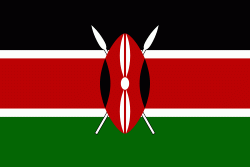University of Nairobi (University of Nairobi)
The University of Nairobi (uonbi or UoN; Chuo Kikuu cha Nairobi) is a collegiate research university based in Nairobi. It is the largest university in Kenya. Although its history as an educational institution dates back to 1956, it did not become an independent university until 1970. During that year, the University of East Africa was split into three independent universities: Makerere University in Uganda, the University of Dar es Salaam in Tanzania, and the University of Nairobi in Kenya.
During the 2011 academic year, the university had 61,912 students, of whom 49,488 were undergraduates and 12,424 postgraduates. The university launched several policy frameworks and introduced self-funded enrollment (also called 'module 2') to cope with the rising demand for higher education in Kenya.
As of 2022, University of Nairobi reported that it had more than 84,000 enrolled students.
The inception of the University of Nairobi dates back to 1956, with the establishment of the Royal Technical College, which admitted its first group of A-level graduates for technical courses in April the same year. The Royal Technical College was transformed into the second university college in East Africa on 25 June 1961 by the Scottish mathematician Professor James Morton Hyslop, formerly of the University of Witwatersrand under the name Royal College of Nairobi. It joined the University of London's 'schemes of special relations' and began preparing students in the faculties of Arts, Science and Engineering for University of London award degrees. Meanwhile, students in other faculties such as the Faculty of Special Professional Studies (later renamed Faculty of Commerce) and Faculty of Architecture continued to offer diplomas for qualifications of professional bodies/institutions.
On 20 May 1964, the Royal College of Nairobi was renamed University College Nairobi as a constituent college of the Federal University of East Africa. During this time, enrolled students studied for college degrees awarded by the University of East Africa instead of the University of London. In 1970, it transformed into the first national university in Kenya and was renamed the University of Nairobi. The university tops in Kenya's university ranking. It is ranked 7th in Africa and 1698 in the world according to Webometrics Ranking of World Universities.
During the 2011 academic year, the university had 61,912 students, of whom 49,488 were undergraduates and 12,424 postgraduates. The university launched several policy frameworks and introduced self-funded enrollment (also called 'module 2') to cope with the rising demand for higher education in Kenya.
As of 2022, University of Nairobi reported that it had more than 84,000 enrolled students.
The inception of the University of Nairobi dates back to 1956, with the establishment of the Royal Technical College, which admitted its first group of A-level graduates for technical courses in April the same year. The Royal Technical College was transformed into the second university college in East Africa on 25 June 1961 by the Scottish mathematician Professor James Morton Hyslop, formerly of the University of Witwatersrand under the name Royal College of Nairobi. It joined the University of London's 'schemes of special relations' and began preparing students in the faculties of Arts, Science and Engineering for University of London award degrees. Meanwhile, students in other faculties such as the Faculty of Special Professional Studies (later renamed Faculty of Commerce) and Faculty of Architecture continued to offer diplomas for qualifications of professional bodies/institutions.
On 20 May 1964, the Royal College of Nairobi was renamed University College Nairobi as a constituent college of the Federal University of East Africa. During this time, enrolled students studied for college degrees awarded by the University of East Africa instead of the University of London. In 1970, it transformed into the first national university in Kenya and was renamed the University of Nairobi. The university tops in Kenya's university ranking. It is ranked 7th in Africa and 1698 in the world according to Webometrics Ranking of World Universities.
Map - University of Nairobi (University of Nairobi)
Map
Country - Kenya
 |
 |
| Flag of Kenya | |
Kenya's earliest inhabitants were hunter-gatherers, like the present-day Hadza people. According to archaeological dating of associated artifacts and skeletal material, Cushitic speakers first settled in Kenya's lowlands between 3,200 and 1,300 BC, a phase known as the Lowland Savanna Pastoral Neolithic. Nilotic-speaking pastoralists (ancestral to Kenya's Nilotic speakers) began migrating from present-day South Sudan into Kenya around 500 BC. Bantu people settled at the coast and the interior between 250 BC and 500 AD. European contact began in 1500 AD with the Portuguese Empire, and effective colonisation of Kenya began in the 19th century during the European exploration of the interior. Modern-day Kenya emerged from a protectorate established by the British Empire in 1895 and the subsequent Kenya Colony, which began in 1920. Numerous disputes between the UK and the colony led to the Mau Mau revolution, which began in 1952, and the declaration of independence in 1963. After independence, Kenya remained a member of the Commonwealth of Nations. The current constitution was adopted in 2010 and replaced the 1963 independence constitution.
Currency / Language
| ISO | Currency | Symbol | Significant figures |
|---|---|---|---|
| KES | Kenyan shilling | Sh | 2 |
| ISO | Language |
|---|---|
| EN | English language |
| SW | Swahili language |















